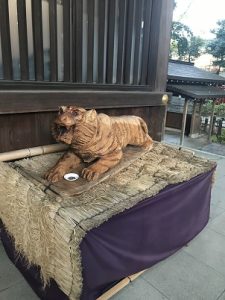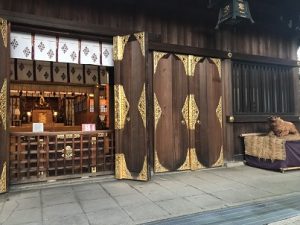意外に知らない若宮八幡社(愛知県名古屋市千種区姫池通 骨董買取 古美術風光舎名古屋店)
2022.12.20
皆さま、こんにちは。スタッフNでございます。
先日、知人のオペラを見に岐阜に行って参りました。
コンサートは好きでよく行っておりましたが、オペラは中々行かないので貴重な経験でございました。
パイプオルガンのある広々とした空間でしたので、音が豪華で素敵でした。
岐阜バスに久しぶりに乗ったのですが、マナカが使えないので現金を握りしめて足りるかドキドキ。
しかも、初めてのホールで入り口がわからず、全面ガラス張りのドアをかたっぱしから引いていると、中から慌てて係りの人がいらして「こっちこっち!」と指をされる始末。
Nは完全に不審者でしたが、何とか中に入ることができました。
そして、開演後でしたので、2階のテラス席へ案内され、休憩中に1階に移動するように促されました。
景色が良かったので、「この場所でもいいですよ」とお伝えすると「ここは開放しておりませんので、下の階へご移動ください」とのこと。
色々といつも通りのうっかりNでございました。
さて、先日若宮八幡宮に行って参りました。

若宮八幡宮は白川公園と名古屋パルコの間にございます。
いつも通る道なのですが、中に入ったことがないということで行ってみますと、大きな木彫りの虎がおりました。
もうすぐ寅年も終わりですね。
Nは虎が大好きで、東山動植物の虎を1人で30分以上見続けていることもございます。
動物占いで虎の方とも相性がいい気がします。
街の中心にあり、普段何気なく見ている場所ですが、この機会に調べてみました。
基本的には本宮の摂・末社として主祭神の御子(みこ)を神に祀(まつ)る社(やしろ)をいいますが、ときに本宮に対してその主神の分霊を勧請(かんじょう)した社を若宮といい、また非業の死を遂げた怨霊(おんりょう)を慰め鎮めるために祀った社を若宮と称する例も少なくありません。
若宮神社は、治承年間(1177~1180年)、平重盛が丹波の国守をしていた時、山城の国(京都府南部)石清水八幡宮の権殿に祀られている御祭神・仁徳天皇の御分霊を、この地に迎えたものと伝えられています。
若宮八幡宮のご祭神は、「仁徳天皇」「応神天皇」「武内宿禰命(たけのうちすくねのみこと)」で、家内安全、国家安泰のご利益があります。 境内にはクスノキや銀杏、橘、桜などの木が枝を広げております。
社伝によれば、奈良時代初期の養老2年(718年)に勧請されたそうです。
一説に、甲賀武士53家の一つ、大河原氏の祖である足利又太郎を祀っているとか。
商売繁盛や選挙にご利益がある神様として知られ、各地から熱心な参拝者が訪れます。
境内社に熱田神社、津島神社、愛宕神社、そして元伊勢の伝承が残る皇大神宮がございます。
縁結びや「神結び願いの緒」が有名で毎月1日の限定御朱印も人気だそうです。
文武天皇大宝年間(697年~707年)に那古野庄今市場(現在の名古屋城付近)に創建。
天文元年(1532年)に「織田信秀(おだのぶひで)」公の那古野城攻めの際、戦火によって社殿を焼失しました。
天文8年(1539年)に再建し、「豊臣秀吉」公から社領200石を寄進されました。
慶長15年(1610年)には「徳川家康」公の名古屋城築城の際に社殿を現在地に遷座し名古屋の総鎮守と定めました。
昭和20年(1945年)の名古屋大空襲により社殿を焼失しましたが、昭和32年(1957年)に再建され現在に至ります。
ご祭神は「仁徳天皇(にんとくてんのう)」「応神天皇(おうじんてんのう)」「武内宿禰(たけうちのすくね)」です。
境内には縁結び・夫婦和合で有名な「道理稲荷社」「道理稲荷社奥之院」や「神結び願いの緒」で有名な「神御衣神社(みころもじんじゃ)」等、参拝すべき境内社も多数ございます。
所要時間は30分もかからないくらいでしたので、皆さまも栄にいらした際は立ち寄ってみてはいかがでしょうか。
ではでは

Hello everyone. I am Staff N.
The other day, I went to Gifu to see an acquaintance’s opera.
I liked concerts and often went to them, but I rarely go to opera, so it was a valuable experience.
It was a spacious space with a pipe organ, so the sound was gorgeous and wonderful.
I took the Gifu bus for the first time in a long time, but I couldn’t use manaka, so I was nervous about whether I would have enough cash.
What’s more, it was my first time in the hall, and I couldn’t find the entrance.
N was completely suspicious, but managed to get inside.
And since it was after the performance, I was guided to the terrace seat on the second floor and was urged to move to the first floor during the break.
The view was nice, so when I told him that this place would be fine, he said, “This place is not open to the public, so please move downstairs.”
As usual, I was carelessly N in various ways.
Well, the other day I went to Wakamiya Hachimangu Shrine.
Wakamiya Hachimangu Shrine is located between Shirakawa Park and Nagoya Parco.
It’s a road I always pass, but I’ve never been inside, so when I went there, there was a big carved tiger.
The Year of the Tiger is almost over.
N loves tigers, and has been watching tigers in Higashiyama fauna and flora for more than 30 minutes by himself.
I feel that it is compatible with tigers in animal fortune-telling.
Located in the center of the city, it is a place that I usually look at casually, but I took this opportunity to check it out.
Basically, it refers to a shrine that enshrines the child of the main enshrined deity as a subordinate and subordinate shrine of the main shrine. A shrine is called Wakamiya, and there are many cases where a shrine enshrined to comfort and appease a vengeful spirit who died violently is called Wakamiya.
Wakamiya Shrine is the enshrined deity of Emperor Nintoku, who was enshrined in the Gonden of Iwashimizu Hachimangu Shrine in Yamashiro Province (southern part of Kyoto Prefecture) when Taira no Shigemori was the governor of Tanba during the Jisho era (1177-1180). It is said that the spirit of the shrine was welcomed to this place.
The enshrined deities of Wakamiya Hachimangu Shrine are “Emperor Nintoku”, “Emperor Ojin”, and “Takenouchi Sukune no Mikoto”, and there are blessings for family safety and national security. Trees such as camphor, ginkgo, tachibana, and cherry trees spread their branches in the precincts.
According to the shrine’s tradition, it is said that the shrine was commissioned in the 2nd year of Yoro (718) in the early Nara period.
According to one theory, Matataro Ashikaga, the founder of the Okawara clan, one of the 53 Koga samurai families, is enshrined here.
It is known as a deity that benefits business prosperity and elections, and is visited by enthusiastic worshipers from all over the country.
The precincts include Atsuta Shrine, Tsushima Shrine, Atago Shrine, and Kotaijingu Shrine, where the legend of former Ise remains.
The Wakamiya Festival is a big festival known as one of the three major festivals in Nagoya, and is held on May 15th and 16th every year at Wakamiya Hachiman Shrine, the main shrine of Nagoya.
For some reason, even in the middle of the city, greenery and traditional architecture make me feel calm.
It is famous for matchmaking and the “Kamimusubi Wishing Cord”, and the limited-edition goshuin on the 1st of each month is also popular.
It was built in the Shoima market in Nagoya (near present-day Nagoya Castle) during the reign of Emperor Monmu (697-707).
In 1532, the shrine building was destroyed by fire when Oda Nobuhide attacked Nagoya Castle.
It was rebuilt in Tenmon 8 (1539), and 200 koku of shrine land was donated by Lord “Toyotomi Hideyoshi”.
In the 15th year of Keicho (1610), when Tokugawa Ieyasu built Nagoya Castle, the shrine was relocated to its current location and designated as the general guardian deity of Nagoya.
The main building was destroyed in the Great Nagoya Air Raid in 1945, but it was rebuilt in 1957 and continues to this day.
The enshrined deities are “Emperor Nintoku”, “Emperor Ojin” and “Takeuchi no Sukune”.
In the precincts, you should visit places such as “Dori Inari Shrine” and “Dori Inari Shrine Okunoin”, which are famous for marriage and marital harmony, and “Mikoromo Shrine”, which is famous for “Kamimusubi Negai no Oo”. There are also many shrines within the precincts.
It took less than 30 minutes, so why don’t you stop by when you come to Sakae?
The other day, an actor said on TV that he goes to a shrine every day.
He is a very energetic person, so he may be receiving power from the shrine every day.
At Antique Fukousha, we also purchase wood carvings.
See you soon
********************
ご実家の整理やお片付けなどをされている方のご相談などが多くございます。
朝晩お寒くなってまいりましたので、お片付けなどくれぐれもご無理のないようになさってくださいませ。
風光舎では古美術品や骨董品の他にも絵画や宝石、趣味のお品など様々なジャンルのものを買受しております。
お片付けをされていて、こういうものでもいいのかしらと迷われているものでも、どうぞお気軽にご相談下さいませ。
また風光舎は、出張買取も強化しております。ご近所はもちろん、愛知県内、岐阜県、三重県その他の県へも出張いたします。
まずは、お電話お待ちしております。
愛知県名古屋市千種区姫池通
骨董 買取【古美術 風光舎 名古屋店】
TEL052(734)8444
10:00-17:00 OPEN
#骨董古美術買取#出張買取#高価買取#無料査定 #若宮八幡宮 #若宮神社 #栄

